You text your partner a pic of the chocolate bar you want from the store. You mention your fave new shampoo in a WhatsApp message. You share an amazing Hootsuite blog article to your work Slack (hint!). Welcome to dark social.
Don’t worry, dark social isn’t the same as the notorious “dark web” trying to lure you into evil. Dark social is the oldest social network in action: private, untraceable human-to-human communication. And it’s responsible for up to a shocking 95% of your web traffic.
With the right tools and knowledge, you can track dark social mentions and shares to find where people talk about your brand, what they’re saying, and how to reach new audiences.
May the Force first-party data be with you.
Dark social is sharing content or mentioning brands on private social media channels, including through direct messaging, email, private groups, and more. Dark social media, or dark traffic, isn’t easily tracked by traditional analytics tools. The term “dark social” was invented in 2012 by Alexis Madrigal, former editor of The Atlantic.
Common examples of dark social are:
- Private messaging apps (e.g. WhatsApp, Discord, Slack, text messages)
- Emails
- Private messages inside native apps (e.g. Facebook Messenger, Instagram, etc)
- Web traffic sources, if someone clicks a link to your website from an unsecured page. (Although HTTPS -> HTTP referral sources are sometimes included.)
- Private social media channels, such as closed Facebook Groups, private subreddits, or personal profile content shared only with friends/followers.
- Word of mouth, including podcast mentions, in-person conversations, or you and your bestie on the phone.
Dark social sources often can’t be measured because they’re private, like an email, or because analytics software can’t accurately categorize them — either because the source is hidden, or the link doesn’t have UTM parameters. (Hold tight: I cover what UTMs are and how to create them later.)
1. Everyone uses dark social
It’s not a matter of if your customers use dark social platforms, it’s which ones.
For example, have you sent an email today? A text? Talked on the phone? Browsed a Facebook Group? Then you’re on dark social a lot at multiple points during the day — just like everyone else.
Even clicking a link in WhatsApp is dark social, and it’s the third most popular social media network in the world, ahead of Instagram, TikTok, Twitter, and Pinterest.
2. Dark social impacts your analytics
Past studies estimated dark social was responsible for as much as 84% of all referral traffic. What about in 2024? No one knows exactly how much web traffic or social media mentions come from dark social because it’s dark social. That’s the whole point.
But analytics expert Steve Lamar recently conducted an experiment to see what Google Analytics classifies as dark social. The results, first published on SparkToro, are pretty surprising.
Steve created 16 new subdomains and directed each traffic source to a matching page name (e.g. “website.com/facebook-messenger” for Facebook Messenger) to track where referrals came from, even if Google Analytics couldn’t tell.
His experiment found that, in 2024, dark social accounts for:
- 100% of TikTok profile clicks. (Yikes!)
- 100% of clicks from private messaging apps (Slack, Discord, WhatsApp, Mastodon) but somehow only 75% of clicks from Facebook Messenger.
- A mixed bag elsewhere, with Instagram passing through accurate attribution data only 30% of the time, LinkedIn 14%, and Pinterest 12%.
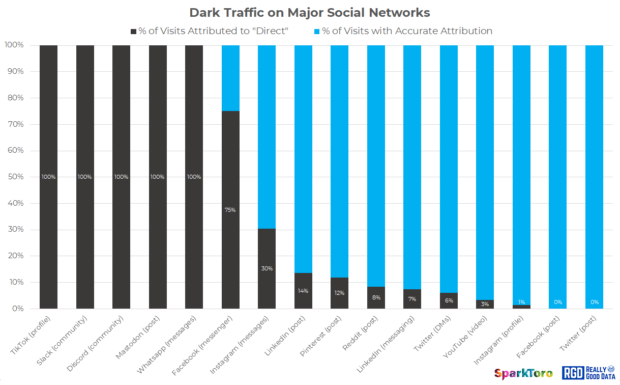
Source: SparkToro/Really Good Data
How much of your traffic is coming from dark social? Your direct traffic in Google Analytics is a good estimate. Find yours under Acquisition -> Traffic acquisition.
Sure, some direct visitors are really typing www.yourcompany.com into their browser. But it’s also where Google puts anything it can’t attribute anywhere else, a.k.a. dark social.
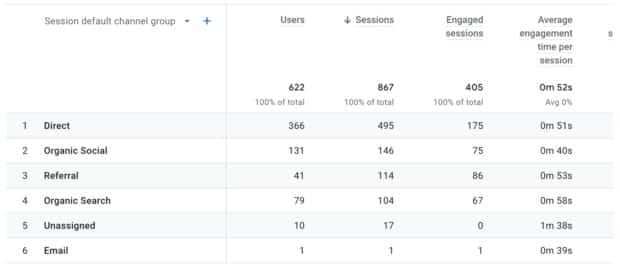
Source: Google Analytics
To dive deeper into where that direct traffic really came from, you need to know your social media analytics numbers. Social media analytics and link in bio tools will help you track link clicks across your social channels.
3. Dark social reaches new audiences
Every day it seems there’s a new study talking about Gen Z scrolling social media behind their closed, sleeping eyelids. I jest, but in reality, 54% of Gen Zers spend 4 or more hours a day on social media compared to only 28% of all American adults.
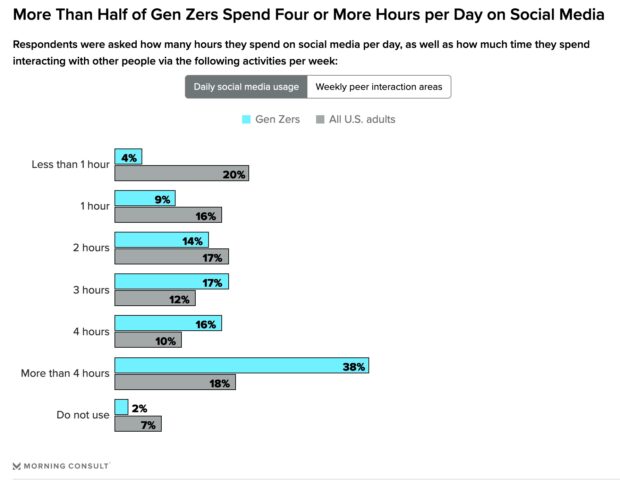
Source: Morning Consult
Great news for social media marketers, but what if your target audience isn’t Gen Z? Social media usage among older adults is rising, but less than half of people 65+ use traditional social media at all, and the ones who do are there to keep in touch with friends and family, not brands.
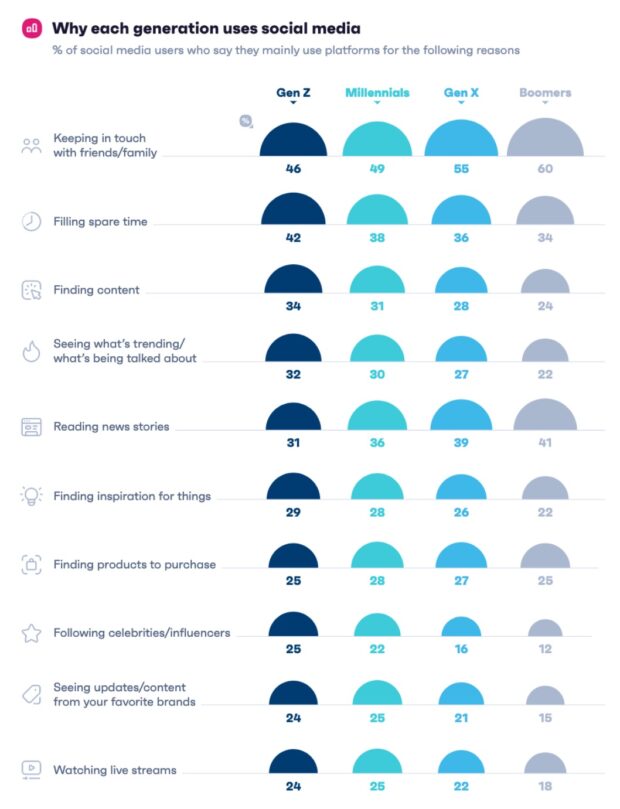
Source: GWI
When it comes to social selling, 43% of Gen Z ranks influencer recommendations as highly relevant to their decision-making process, whereas only 18% of Gen X and 9% of Boomers say the same.
Understanding your audience’s generational differences goes a long way toward finding out where they spend time, both online and offline, and how to reach them on their favorite dark social channels, such as in-person events or private groups.
4. Dark social provides valuable information
Dark social is all about connection. People join private Facebook Groups or forums to meet and talk with other like-minded people. A lot of that talk centers around advice.
For example, people in the final stages of researching a purchase will often ask others their opinion, like in r/Fujifilm:

Source: r/Fujifilm on Reddit
I know Reddit isn’t strictly a dark social channel (only private subreddits are), but it shows the specific types of questions people ask in niche forums like this, which is great for Reddit market research.
In an era when you can watch 700 review videos for a product on YouTube, we still turn to people we consider experts — friends, family, or niche communities — for purchasing advice. For 89% of buyers, personal referrals and recommendations are still their most trusted source.
Dark social helps you find these powerful sources. Continuing the photography example above, a camera store may discover a local enthusiasts’ group and partner with them to run sponsored events or info sessions. Or, learn new questions buyers have about products and use that to revise their product descriptions or FAQ pages.
Plus, knowing what people discuss in dark social channels can inspire a goldmine of new social media content.
You can’t track everything, but there are ways to see through the murky swamps of dark social to find the data you’re looking for.
1. Use a URL shortener
Besides making your social posts tidy, shortening links also lets you add tracking information for accurate analytics measurement.
It really can’t get easier: Shorten links on-the-fly inside Hootsuite Composer with our included Ow.ly URL shortener.

You can also customize Ow.ly links to pass through accurate analytics parameters or write your own custom ones, which is especially useful for tracking specific campaigns or promotions.
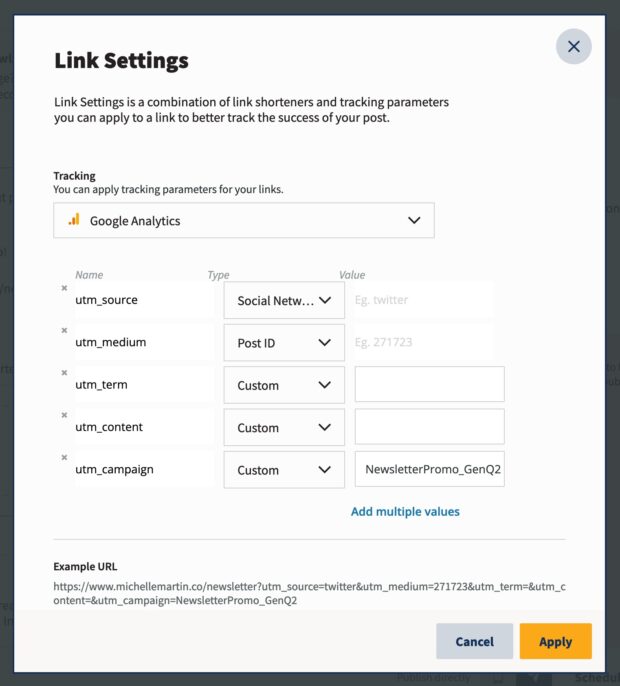
2. Set up UTMs and referral links
A “UTM link” is simply a URL with tracking parameters in it, exactly like the above example from our Ow.ly link shortener. You don’t need software to make these links. Anyone can create UTMs and referral links, as long as you format it correctly.
Although without a URL shortener, you’ll end up with a long, ugly link like this:
https://blog.hootsuite.com/chatgpt-social-media/?utm_campaign=all-alwayson-none-glo----owned_media-blog_newsletter_2023_06_14---&utm_source=blogheadline&utm_medium=email&utm_content=blogEach of those items beginning with “utm_” is a UTM tracking parameter. Common ones include:
- Source (Facebook, Instagram, email, etc)
- Medium (organic social, paid social, website, etc)
- Term (keyword used or differentiate between A/B tests)
- Content (the type of content, like a video, photo, etc)
For a step-by-step tutorial, check our complete guide to creating links with UTM parameters.
3. Create a social listening strategy
Social listening tools can’t track 100% of dark social activities, like text messages, but they can help attribute traffic and ROI as accurately as possible. Plus, social listening mines the web for conversations you wouldn’t otherwise know about.
For example, I’ve been looking for a new tiny-but-holds-everything backpack and reading tons of online reviews. But what really sold me on the one I wanted was reading real user feedback from people like Chris, who isn’t affiliated with this review or website, but took the time to answer questions in the comments.
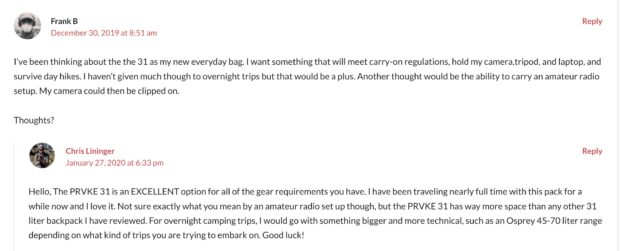
Source: The Broke Backpacker
For high-end products like a $400+ backpack, customers often have super specific questions. Chris’ answers are valuable because they come from real, personal experience. Social listening finds these valuable customer data opportunities to improve your messaging, and brand champions to approach for potential collaborations.
Luckily, every Hootsuite plan includes everything you need to get started with social listening.
Use Quick Search to discover trending hashtags, brands and events anywhere in the world, or dive deeper for personalized insights on your brand.
You can track what people are saying about you, your top competitors, your products — up to two keywords tracking anything at all over the last 7 days.

Plus, you can use Quick Search to analyze things like:
- Key metrics. Are more people talking about you this week? What’s the vibe of their posts? Hootsuite Listening doesn’t just track what people are saying — it uses enhanced sentiment analysis to tell you how they really feel.
- Top themes. How are people talking about you? What are the most popular positive and negative posts about? Which other conversations are you showing up in?
- Results. Ready to get into specifics? The results tab will show you a selection of popular posts related to your search terms — you can filter by sentiment, channel, and more.

And if you want to take social listening to the next level, our upgraded listening can show you sentiment over time, top influencers in your space, audience demographics, and much more. Interested in a free demo? Book one now.
4. Make sharing easy
Do you have sharing buttons on your blog articles for more than Facebook, Twitter, or Pinterest? Try adding email or WhatsApp sharing buttons with — you guessed it — UTM parameters. For anyone clicking those links, you’ll know where they came from and which article they read.
It’s also always a safe bet to add UTM parameters to the “regular” social media buttons for ultra-accurate tracking.

Source: The Globe and Mail
5. Create your own dark social community
Brand-run private communities take time and effort to manage but when done right, can provide huge ROI.
Device skin maker dbrand’s subreddit r/dbrand is public, but it’s a great example of a company successfully engaging loyal fans while also staying true to their brand. (No easy feat.) Customers share everything from their latest dbrand purchase to new product ideas, and — most importantly — help each other with advice and post organic content that helps build the brand.
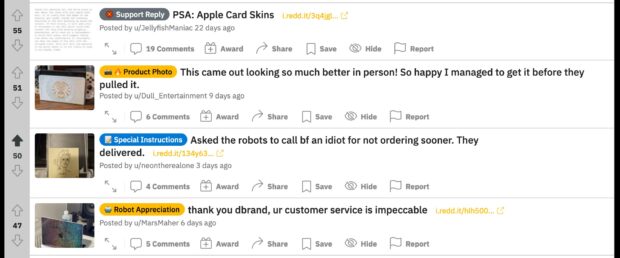
Source: r/dbrand
Of course, you’ve gotta set the tone of your community with rules and guidelines and spend time moderating content. But dbrand also proves it doesn’t need to be complicated:

Source: r/dbrand
Your own dark social community is like having a focus group ready to go 24/7. It’s a direct line to your most valuable customers.
6. Be transparent about data usage
People are less willing than ever to part with personal data. Research from Adobe found 73% of people worry brands use their personal data only to benefit themselves, not to provide better customer experiences. A recent Cisco survey shows 89% of consumers care about and want control of their data, and 44% of those have switched companies due to disagreeing with data sharing and privacy policies.
With more people concerned about privacy, and with 80% of countries having current or draft privacy law legislation, it’s important to have a defined data policy.
Different industries and countries have different legal requirements for handling customer data. Unsure exactly what your responsibilities are? While it’s not legal advice, our social media compliance is a good starting point.
What is an example of dark social?
Common dark social examples are private messages sent on Facebook Messenger, WhatsApp, or text messaging, emails, or private social networks such as Facebook Groups, Discord servers, or forums.
What are dark social strategies?
Dark social media strategies include using private social networks in your marketing, including brand-owned closed communities and encouraging employee advocacy, as well as setting up UTM parameters to accurately track dark social referral traffic.
What are dark posts?
Dark social posts are content posted or shared through dark social media, which are private channels like texts, emails, or private messages. Dark posts can also refer to paid social media ads that aren’t displayed on a brand’s organic profile and shown only to specific target audiences.
What is dark social web traffic?
Dark social web traffic is any visit to your website that analytics software can’t accurately determine the source of, including traffic redirected from a secure (HTTPS) website to a non-secure (HTTP) URL. This is often labeled as “direct” referral traffic in Google Analytics and other platforms.
Hootsuite makes it easy to monitor keywords and conversations on social media, so you can focus on taking action on the insights available. Try it free today.








